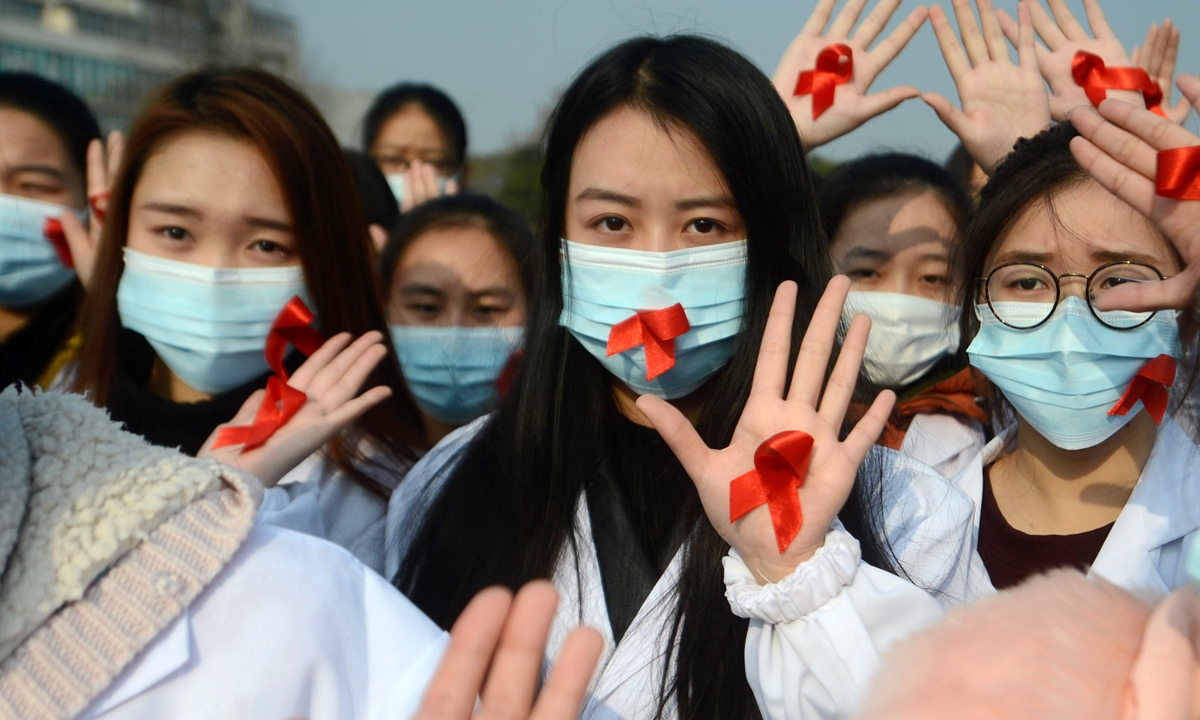
Students of Yangzhou University in East China’s Jiangsu Province, put red ribbon on their hands as an appeal to eliminate social discrimination against HIV patients on World AIDs Day. File Photo: cnsphoto
China has released the 2024 version of guidelines for the diagnosis and treatment of HIV/AIDS, which further enriches the theoretical and practical system of HIV diagnosis and treatment, and identifies HIV vulnerable populations for the first time.
The Global Times learned from the infectious diseases branch with the Chinese Medical Association that the latest version of the guidelines, released in early May, includes 14 aspects such as prevention of HIV mother-to-child transmission and single-positive family reproduction, as well as pre-exposure and post-exposure prevention and blocking of HIV infection.
It focuses on updating and adding content related to HIV antiviral therapy (ART), opportunistic infections, HIV-associated tumors, and prevention and intervention of HIV infection. It also introduces the chapter on "HIV immune function reconstruction deficiency" for the first time, as well as the concept of "HIV vulnerable populations."
Li Taisheng, director of the infectious diseases branch with the Chinese Medical Association and director of the Infectious Diseases Department of Peking Union Medical College Hospital, who had participated in the drafting of the latest guidelines, told the Global Times that the release of the guidelines is of great significance for promoting the standardization of clinical diagnosis and treatment of HIV/AIDS and improving the quality of life for patients, and will have a profound impact on enhancing the level of HIV/AIDS diagnosis and treatment in China.
In order to improve the early diagnosis level of HIV, the new version of the guidelines for the first time clearly defines the threshold of 1,000 copies/mL for HIV infection nucleic acid diagnosis standards, providing a more accurate basis for clinical judgment.
The guidelines recommend HIV infection cases, regardless of CD4+ T lymphocyte levels, to start ART as early as possible to reduce morbidity and mortality; diagnosed patients to rapidly initiate ART (within 7 days after diagnosis) or start ART on the day of diagnosis.
The new version of the guidelines first proposes diagnostic criteria and clinical treatment measures for HIV immune function reconstruction deficiency.
The latest version of the guidelines also introduces the concept of HIV vulnerable populations for the first time, including patients over 50 years old, children, pregnant women, late-diagnosed patients, patients with multiple underlying diseases, patients with highly suppressed immunity such as CD4+ T lymphocyte counts <50/µL, and patients with immune function reconstruction deficiency after ART. These patients should be more actively treated with ART, actively treat underlying diseases, and pay attention to multidisciplinary cooperation, according to the guidelines.
The guidelines also emphasize that HIV/AIDS patients are at increased risk of severe illness when combined with infections such as novel coronavirus and monkeypox virus, and attention should be paid to strengthening the prevention and treatment of such diseases.




